May 8, 2009
Air Date: May 8, 2009
FULL SHOW
SEGMENTS
Lubchenco’s Climate Service
View the page for this story
NOAA Administrator Jane Lubchenco wants to start a National Climate Service to help farmers, fishermen and city planners better deal with the coming challenges from a changing climate. Host Jeff Young sat down with Lubchenco to get her thoughts on how science should guide our decisions on climate change. (08:00)
Chasing Twisters
View the page for this story
For the next month, more than 100 researchers will caravan around the Midwest hoping to get in the path of a tornado. Roger Wakimoto is director of the Earth Observing Laboratory for the National Center for Atmospheric Research. He tells host Steve Curwood that despite past research, scientists still don't really know how tornadoes form. (04:00)
Goodbye DDT
View the page for this story
Three years after endorsing the use of DDT in poor countries to control malaria, the World Health Organization is reversing its policy. The goal is to completely phase out the use of the toxic pesticide by 2020. Brenda Eskenazi, an epidemiologist at UC Berkeley, tells host Steve Curwood that mounting research on DDT's negative health effects helped convince public health officials to seek non-chemical alternatives to counter malaria. (06:00)
A Home for Jaguars
View the page for this story
Jaguars travel amazing distances on their migration routes – trekking from Mexico all the way through most of South America. They cross canals, towns, ranches and plenty of people who are less than happy to see them. Host Jeff Young talks with Dr. Alan Rabinowitz, president of the conservationist group, Panthera, about a novel way to get humans to co-exist with cats. (06:10)
Energizing Biofuel
View the page for this story
The Obama administration has given the biofuels industry a major boost. It’s providing the agro-energy industry with nearly three quarters of a billion dollars and proposing new rules to help accelerate development of advanced fuels. Host Steve Curwood talks with Jim Lane, publisher and editor of BioFuels Digest about the future of biofuels. (05:30)
Note on Emerging Science
View the page for this story
What’s the difference between a harmless grasshopper and the Biblically notorious locust? Apparently, just a dose of serotonin. Lindsay Breslau reports on the Dr. Jekyll and Mr. Hyde of the insect world. (02:00)
Food Deserts
/ Jessica Ilyse KurnView the page for this story
Many low-income neighborhoods in the United States lack access to fresh and affordable fruits and vegetables. Residents in these so-called ‘food deserts’ rely on neighborhood corner stores and fast food chains as their main sources of food. But, as Jessica Ilyse Kurn reports from New York City, a number of programs are working to close the food gap by bringing healthy foods close to home. (08:00)
Eco IQ
View the page for this story
There’s more than just one type of smarts - book smarts, street smarts, emotional smarts...and now eco smarts. Daniel Goleman, author of Ecological Intelligence, takes host Steve Curwood to a drugstore to see what brands of shampoo are ecologically intelligent. (07:00)
Show Credits and Funders
Show Transcript
Hosts: Steve Curwood and Jeff Young
Guests: Brenda Eskenaz, Dan Goleman, Jim Lane, Jane Lubchenco, Alan Rabinowitz, Roger Wakimoto
Reporter: Jessica Ilyse Smith
Science Note: Lindsay Breslau
[THEME]
CURWOOD: From Public Radio International - this is Living on Earth.
[THEME]
CURWOOD: I’m Steve Curwood.
YOUNG: And I’m Jeff Young.
A top government scientist wants to help farmers, fishermen and city planners better prepare for a changing climate.
LUBCHENCO: How to think about drought, floods, fire, insect outbreaks--the ability to have an idea of what’s down the road is immensely useful in planning. And there is no one place they can go.
YOUNG: NOAA administrator Jane Lubchenco's idea for a National Climate Service.
CURWOOD: Also – how hard it is to find healthy food choices in inner city shops.
BARONBERG: People would say to me I really want to make these changes, I want to switch to one percent milk, I want to eat more fruits and vegetables, I want to be healthier but I can’t. My bodega only sells junk food and there aren’t any supermarkets. So what am I supposed to do?
CURWOOD: Eating in the city - and more - this week on Living on Earth! Stick around.
[NEWSBREAK MUSIC: Boards Of Canada “Zoetrope” from “In A Beautiful Place Out In The Country” (Warp Records 2000)]
ANNOUNCER: Support for Living on Earth comes from the National Science Foundation and Stonyfield Farm.
Lubchenco’s Climate Service

Marine biologist Jane Lubchenco at work. (Courtesy of Oregon State University)
[THEME]
CURWOOD: From the Jennifer and Ted Stanley studios in Somerville, Massachusetts, this is Living on Earth. I’m Steve Curwood.
YOUNG: And I’m Jeff Young in Washington.
If Mark Twain were still with us he might say, “Everybody talks about the changing climate but nobody does anything about it.”
Well, Jane Lubchenco does plan on doing something about it. She’s the marine scientist President Obama chose to lead NOAA, the National Oceanic and Atmospheric Administration. Lubchenco wants NOAA to start a National Climate Service—sort of like the National Weather Service, only this would forecast what climate change might mean for regions of the country over the coming decades.
I caught up with Lubchenco here on Capitol Hill just after a congressional hearing on that proposal. She says we can no longer rely solely on past experience to guide our decisions on basics like agriculture, water and land use.
LUBCHENCO: We have designed our cities, planted our crops, designed pretty much everything based on the expectation of some reasonable predictability in our climate system. We’re seeing now that the climate is changing. It’s getting warmer and more variable. We’re seeing more extreme precipitation events, floods and droughts. We’re seeing sea level rise, ice caps melting. And all of those are telling us that the climate is changing and changing in ways that are different from what it used to be.
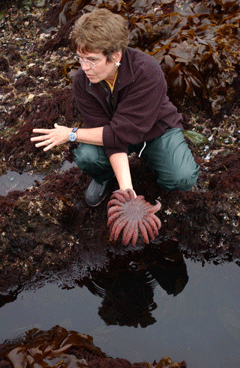
Jane Lubchenco. (Courtesy of NOAA)
YOUNG: Yeah, I’m guessing, if I’m say- someone who deals with a water district in California, and I’m hearing all this scary stuff about the snow pack being gone I’m probably on the phone saying, help me out here, what should we do?
LUBCHENCO: That’s exactly right. And changes from snow pack to rainfall have huge implications for not only what the amount of water is throughout a year, but when it’s available, and those kinds of fundamental changes in the availability of water are so basic to planning, not just for city managers, but for agricultural, for traffic on rivers, how to think about droughts, floods, fire, insect outbreaks - the ability to have an idea of what’s down the road, even though it’s not super precise, is immensely useful in planning. So there are lots and lots of requests now - by water managers, by city planners, and others - for information, and there’s no one place they can go.
YOUNG: As I understand it, we have a pretty good grasp of what climate change might mean if you’re talking about a really big chunk of land or ocean, and a really a long time scale. But if I’m a community planner, or an agricultural planner, a fisherman, what have you, that doesn’t do me much good. How local can we get, and how useful can we make that information?
LUBCHENCO: It’s relevant to take stock of how much our capacity to model has improved through time. It used to be the case that climate models were just the entire earth--the whole thing as a single unit. Well fast forward to the present and we have the ability to have models that are at the scale of a continent. And that is a very significant advance. We would like to push that envelope and to go as rapidly as we can to be able to deliver information at the regional scale for the twenty to fifty year time horizon, because that’s the type information we need and it, in fact, we believe, is doable.

Marine biologist Jane Lubchenco at work. (Courtesy of Oregon State University)
YOUNG: Jane Lubchenco was a natural choice for NOAA. She spent decades trying to further our understanding of how we’re affecting our oceans and atmosphere.
She’s among the country’s most respected marine ecologists. Her work is regularly cited by other scientists and won her a Macarthur “genius” grant.
But she’s no ivory tower academic. Lubchenco’s also worked to make policy reflect the science. Of course that’s a now a big part of her job at NOAA--advising the president and testifying before Congress. And she steps into that role just as Congress starts a high stakes fight over what to do about climate change.
LUBCHENCO: I think it’s unrealistic to expect everybody is going to agree on everything, that’s just not the way democracy works. The challenge for science is to communicate what is known by scientists in a way that is as accessible and user friendly and credible. And in this case I think the evidence is overwhelming that climate change is unequivocal. It is time to act and to reduce those greenhouse gas emissions that are causing climate to change.
YOUNG: Do targets the Obama administration is putting forward for reducing greenhouse gases, are they up to the challenge?
LUBCHENCO: I believe targets that the administration has put forward are appropriate targets. It’s not clear what exact right amount is. It is clear we need to get on with it and reduce emissions as rapidly as possible.
YOUNG: I wonder though if the public shares the sense of urgency about this that I gather you have. I heard you speak at the National Academies, and you quoted the Rev. Dr. Martin Luther King.
LUBCHENCO: We cry out desperately for time to pause in her passage, but time is deaf to every plea. Over the bleached bones and jumbled residue of numerous civilizations are written the pathetic words, “too late”
YOUNG: That sounds like a pretty urgent message.
LUBCHENCO: Dr Martin Luther King was referring to what he called the ‘fierce urgency of now’ and I do believe there is intense urgency in addressing climate change.
One thing I think we need to appreciate is the fact that there will be a lot of surprises as climate system is changing. One of those surprises that emerged recently has been the increasing acidity of oceans. As oceans absorb CO2 they become more acidic. That has serious consequences for life in the oceans and in turn for people because we rely on oceans for so many things. There is no easy fix for more acidic ocean waters, and therefore the real focus should be on reducing emissions. There is an intense, fierce urgency of now in reducing greenhouse gas emissions sooner rather than later.
YOUNG: Jane Lubchenco is the ninth administrator of NOAA. To hear a longer version of this interview, and to learn more about the National Climate Service proposal, go to our website, loe.org.
Related links:
- Click here to listen to a longer version of Jeff Young’s interview with Jane Lubchenco
- U.S. House Science subcommittee hearing on National Climate Service
- NOAA
Chasing Twisters
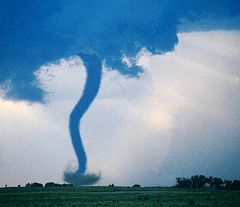
A tornado touches ground in Oklahoma. (Courtesy of National Center for Atmospheric Research)
[TORNADO SOUNDS, MAN “IT’S A TWISTER, A TWISTER”]
CURWOOD: For the next four weeks or so, NOAA researchers are teaming up with some one hundred others, hoping to follow in Dorothy’s footsteps and get up close to a twister.
One of them is Roger Wakimoto, he’s director of the Earth Observing Laboratory at the National Center for Atmospheric Research or NCAR in Boulder, Colorado.
The goal: to find out exactly how violent rotating thunderstorms spawn tornadoes. The name of the project: VORTEX.
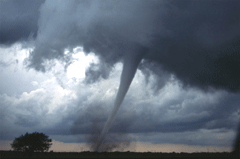
When tornadoes form in relatively dry air, they can appear hollow or translucent. (© UCAR; photo by Linda Lusk)
WAKIMOTO: It’s actually an acronym that I came up with. It stands for the Verification of the Origins of Rotation in Tornados Experiment. I like the acronym because when you hear the term vortex you sorta know what we’re doing. Once you understand what the meaning of the acronym is, I don’t think there’s any question what we’re trying to accomplish in the experiment.
CURWOOD: You’re study area is, what, some 900 miles between Texas to Minnesota. How can you possibly be at the right place at the right time to get to tornado data that you’re looking for?
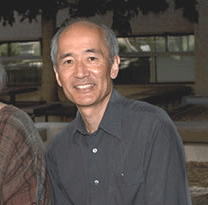
Roger Wakimoto is the director of the National Center for Atmospheric Research Earth Observing Laboratory. (Courtesy of NCAR)
CURWOOD: The National Weather Service now has a warning time of about what thirteen minutes which is enough for people to get cover, but if you don’t hear that warning right away, it’s not all that much. Why is it that tornados are so hard to predict and monitor?
WAKIMOTO: There are a fair amount of large-scale storms that rotate in the Midwest. But only a very small fraction of them actually produce tornados. One of the big hypotheses that we’re looking at right now is exactly what triggers tornado genesis. You may be shocked by my statement saying that’s what we need to try to understand, but tornado genesis itself has been fairly elusive to us, even though we’ve been studying these phenomena for decades.

When tornadoes form in relatively dry air, they can appear hollow or translucent. (© UCAR; photo by Linda Lusk)
CURWOOD: So what do we know about tornado formation at this point? What are the right conditions for it?
WAKIMOTO: The right conditions – as I said earlier, you need a rotating thunderstorm. And actually the ingredients for rotating thunderstorms, we understand really well. It’s really just two things: you need the air to be very unstable, which means that it just wants to rise violently upward, and for most people what that means is very hot, humid conditions at the ground, and relatively cool, dry conditions aloft. And that is very unstable air. The other thing you need is strong winds, increasing with height. You get those two ingredients in the same area then you’re – you have a very high probability of getting a massively rotating thunderstorm. So that we understand. But it’s that next step – which rotating thunderstorm actually has the right ingredients to produce a tornado. That’s the missing link that we still are trying to solve.
CURWOOD: What do you think you might find about tornado genesis in this study?
WAKIMOTO: Well one of the hypothesis that we have about tornado genesis is that it’s very much related to downward air that’s coming from the storm. And in particular the downward air, or down drafts as we call them, might have a particular temperature structure that, for example, very cold down drafts might not be favorable for tornado genesis and very warm downdrafts might be more favorable.

An advancing tornado. (Courtesy of NASA)
CURWOOD: So if someone were to observe that the air temperature were rising if there were a bunch of rotating storms in the neighborhood, that might be a warning that a tornado could happen?
WAKIMOTO: It could be. If we can prove that that’s the case, then maybe we can develop some instrumentation that actually might measure that and be able to predict that a particular storm is going to form a tornado.
CURWOOD: We’ve seen some major shifts in weather patterns as the earth’s temperature has been slowly rising. Is there any connection between the perceived sense that there are more and more tornados now in the U.S. over the last few years and this question of global climatic change?
WAKIMOTO: That’s been something we’ve just started looking at. These early studies have suggested that we might have an increase in severe tornado activity and over a more extensive area in the United States than we’ve been typically accustom to.
CURWOOD: I gotta ask you this: you’re there at that gathering, that party and somebody says, “So, what do you do?” And you tell them “I chase tornados. I study tornados.” They gotta say, “that’s way cool.”
WAKIMOTO: They do. I mean that’s why I got into the business. I’ve been fascinated by it from a very young age.
CURWOOD: Roger Wakimoto is lab director of the Earth Observing Laboratory at the National Center for Atmospheric Research. Thank you.
WAKIMOTO: You’re welcome.
Related link:
For an animation on how tornadoes are formed click here
[MUSIC: Allen Toussaint “Cast Your fate To The Wind” from Soul Classics: High (Charly Records 2006)]
CURWOOD: Just ahead – The World Health Organization calls for the phase out of DDT. Keep listening to Living on Earth.
[CUTAWAY MUSIC: Fareed Haque: “Blu Hindu” from Flat Planet (Owl Studios 2009)]
Goodbye DDT
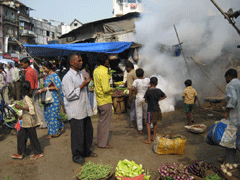
DDT sprayed in a vegetable market in India. (Photo: rzadigi)
YOUNG: It’s Living on Earth, I’m Jeff Young –
CURWOOD: And I’m Steve Curwood.
The pesticide DDT has been banned in the developed world for years now. But the treaty known as the Stockholm convention does allow its use for malaria control – and it’s still widely applied in parts of Africa and Asia.
Well, that’s set to change, because the World Health Organization has reconsidered its 2006 endorsement of the malaria exception for DDT. The WHO is joining forces with the UN Environmental Program to completely phase out DDT worldwide by 2020.
Brenda Eskenazi thinks that's a good idea. She's an epidemiologist at the UC Berkeley School of Public Health, and has just completed a review of more than 500 studies on the pesticide and human health.
Dr. Eskenazi, what did you find - what health problems are associated with DDT?
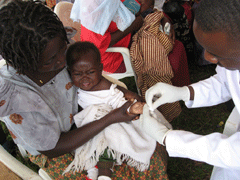
A child is tested for malaria in Ruhiira, Uganda. Every year, nearly a million people die from malaria-- most are children in sub-Saharan Africa. (Courtesy of the Millennium Promise)
ESKENAZI: The studies that have come out have suggested that there are associations with breast cancer, there are associations with effects on the neurobehavioral development of children, there are associations with spontaneous abortion. And there are quite a number of studies that have looked at DDT and diabetes and found an association. But the most interesting work is work out of South Africa in a community where DDT was being used using indoor residual spraying where they actually spray the insides of the mud huts to prevent the mosquitoes from lodging on the walls. And they found that the men that lived there had a dose related decrease in semen quality. And it was very profound, but there are also very, very few studies that have been conducted in the communities where DDT is actively being used in the method its being used currently.
CURWOOD: And I gather in places where it’s used to fight malaria in buildings that people will have much higher body burdens of DDT than we typically see in the west.
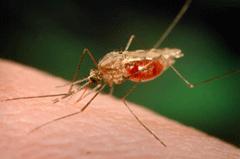
DDT kills mosquitoes that carry malaria.
ESKENAZI: Way out of the range of what we see currently in the west. And even what we ever saw in terms of when DDT was used in the United States, partly because DDT is used specifically indoors in the African communities and so the huts are sprayed, people are not in the homes when they are sprayed, but their pots and pans and their beds and their children’s toys may still be in the homes. And then the families reenter the homes soon after the spraying, maybe the children are playing on the floor, maybe the children will put their hands in their mouths. So the levels that we’re likely to see are going to be so much higher than we probably would have seen in the way it had been used in the United States in the 1960s.
CURWOOD: What were the effects on humans here in the United States from the use of DDT?
ESKENAZI: Well, there’s a recent study that has just come out following up a cohort of women who were pregnant in the 1950s and 60s and they found that those women who were exposed to DDT before the age of 14 had something like a five fold increased risk for breast cancer now. And these are women who were exposed back in the 40s and the 50s and the 60s.
CURWOOD: What does it say for Asian and African women who might be getting exposed to DDT today?
ESKENAZI: I think that’s exactly the concern that we have. The concern is that we’re exposing a population to very, very high levels of DDT now, and we don’t know what’s going to happen to these women or these men in the future. So in the future we may see, maybe twenty years down the road an increase in breast cancer in these populations, we may see a decrease in fertility sooner in time, but we have a good potential to see something based on the literature that we reviewed.
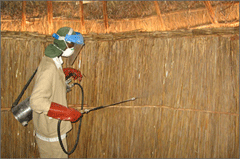
Scientists worry about the health risks posed by the indoor spraying of DDT. (Courtesy of the World Health Organization)
CURWOOD: In 2006, the U.S. was part of an initiative with the World Health Organization to really increase the use of DDT to fight malaria. In your view, how appropriate was that?
ESKENAZI: I think that it was not based on good sound science. I think that maybe DDT was an important way to curtail malaria, but we hadn’t don the research necessary to know whether other adverse effects are happening from that policy. For example, we have no idea what happens to the populations that are immunocompromised that are living in Africa. Where much of the malaria is high is also the same areas where HIV are high. We have no idea how those people are specifically affected by DDT.
CURWOOD: Why do you think the World Health Organization, the WHO, is changing its views on this?
ESKENAZI: Well, I think that the World Health Organization now is going back to the Stockholm Convention as it was intended, which is that DDT can be used, but it needs to be phased out. And it seems that UNF and WHO are endorsing and funding efforts that would allow replacement of DDT in the communities that couldn’t afford to do anything else, and that’s why DDT was in part being used, it was relatively cheap and it was easy. But there are better ways, for example, draining pools of standing water, using different kinds of plants to repel mosquito larva and by clearing vegetation. So there are other things that can be done. And that is where we have to help these communities so that they can step away from use of DDT.
CURWOOD: Brenda Eskenazi is a professor at the University of California Berkeley School of Public Health. Thank you so much, Dr. Eskenazi.
ESKENAZI: Thank you so much.
Related links:
- To read the consensus statement published in the journal Environmental Health Perspectives, click here.
- Learn more about the UN’s program to phase out DDT
- For more about Brenda Eskenazi, click here
[MUSIC: Bill Laswell “Cybotron” from Dub Chamber 3 (Universal Songs Of Polygram Int’l 2000)]
A Home for Jaguars
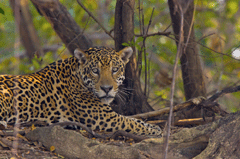
A watchful jaguar in the Pantanal. (Photo: Steve Winter/Panthera.org)
YOUNG: Many of the world’s wild cats face dire threats – shrinking habitat, severed migration routes, and human hunters.
A non-profit group called Panthera is dedicated to preserving the thirty-six species of wild cats. And it’s using some very creative approaches. Its latest project aims to help jaguars in Brazil by first helping people there live better.
Panthera’s president, Dr. Alan Rabinowitz, has long struggled to find effective ways to conserve habitat for these big cats, which have had a deep hold on him for decades.
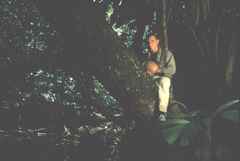
Alan Rabinowitz on the lookout for jaguars in Belize. (Photo: Steve Winter/Panthera.org)
RABINOWITZ: I’ve been involved with jaguars since the late 1970s. It was the first thing I actually did after graduate school, and I was the first one to radio collar jaguars in the jungles and set up the world’s first jaguar preserve in Belize. But since that time we’ve come to realize that jaguars genetically are actually the same from Mexico through Argentina, which was an incredible piece of news when the genetic tools allowed us to discover this. And that took us into a completely new conservation model that instead of following the old traditional paradigm of saving a species by just trying to lock it up in good protected areas – now we have be trying over the last five years to save the jaguar throughout its entire contiguous range, from Mexico through Argentina. While we thought they were being restricted, they were actually coming out of the protected areas and finding their own way between large pockets of forest, even swimming the Panama Canal.
YOUNG: That’s amazing. I mean, yeah – how do they get across the canal?
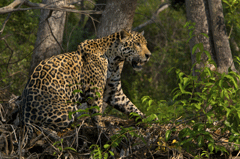
A jaguar approaching a cattle fence in the Brazilian Pantanal. (Photo: Steve Winter/Panthera.org)
RABINOWITZ: That was the first thing I wondered, and I headed straight down to the Panama Canal when I got this news. And sure enough, there’s a great section on the Atlantic coast of the Panama Canal which is solid jungle up to the canal and solid jungle on the other side, and it’s not that wide. It’s wide enough frankly for you and I to swim across. It’s not as if every jaguar that comes there swims across, but to maintain genetic continuity all you need is one jaguar every four or five generations to actually make it across, one young dispersing male usually, and get to the next side.
YOUNG: And that’s keeping them from breaking up into separate geographically discrete populations and becoming separate subspecies.
RABINOWITZ: Exactly. One of the most important - where the largest jaguars on record have always been – is in the Brazilian Pantanal, almost the southern extremity of its range. That area has some of the densest jaguar populations we know throughout its range, and yet it’s very much in threat of being cut off from the rest of jaguar range.
YOUNG: Now the Pantanal – that’s a swamp, right?
RABINOWITZ: It’s the world’s largest swampland, yes.
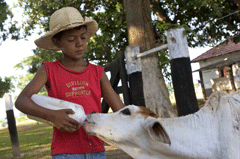
A young rancher feeds a calf on Panthera’s Sao Bento Ranch in the Pantanal. Ranchers blame jaguars for killing cattle. (Photo: Steve Winter/Panthera.org)
YOUNG: It’s also, as I understand it, ranching country. And, you know, my understanding of ranching is that they don’t much like big predators, do they?
RABINOWITZ: Exactly. In ranching country jaguars are viewed as cattle killers, even though the reason most cattle die on these huge, huge ranches are numerous and varied. But jaguars are blamed for almost all the cattle deaths by the ranchers, so it’s been a tradition, it’s a been a history in much ranching country to kill jaguars on sight in order to prevent them from killing cattle and thus losing money.
YOUNG: So, what are you doing to try to get ranchers to get along with jaguars?
RABINOWITZ: So Panthera was involved in actually purchasing some of the ranches, which were up for sale, which allowed us to create the largest Jaguar biological corridor throughout jaguar range. We saved a huge amount of land because there was protected area on both sides and we then hooked it up. If there’s any lesson we’ve learned over the years in conservation, it’s that no matter how many laws you make and now matter how many protected areas you set up, unless you can work with the local people in these areas, then long-term sustainable conservation just will not work.

A watchful jaguar in the Pantanal. (Photo: Steve Winter/Panthera.org)
YOUNG: So how do you do that? How do you make them see benefit in having these big cats around them?
RABINOWITZ: We need to know first what they’re greatest needs are, what they’re perceived needs and desires are. And in the Pantanal they involve basically everything we all want: better lives for their children. So we create incentives or benefits for them living within this jaguar corridor, and those benefits are in the way of setting up schools and bringing health care. And that led us to this incredibly innovative partnership with Mount Sinai Medical School here in New York.
YOUNG: Yeah, tell me about that. This is taking med students from Mount Sinai to what offer services there in Brazil?
RABINOWITZ: We’re not just bringing doctors down. These doctors also have to be trained in conservation. So when the doctors go, they don’t just go there as medical doctors, they go there as conservation medical practitioners.
YOUNG: This is such a fascinating approach. I know form personal experience that often a visit to the doctor is what they call a teachable moment where I’m a little more receptive to messages.
RABINOWITZ: Exactly. Local people often more than urban dwellers really understand the balance between the environment and human health because they live with it every day. So when you start teaching them how maybe part of the reason why their child has this fever or why some of their maladies are occurring has to do with both their livestock and how they keep it or the fact that there are wild jaguars out there and they’re actually living in a nice balanced wild environment, they get it. It’s not a far stretch teaching them that because they intuitively get it more than many people coming in who are instructing them.
YOUNG: Dr. Alan Rabinowitz is president of Panthera and he’s been talking to us about jaguars and people and the land that they share. Thanks very much for your time; I appreciate it.
RABINOWITZ: Thank you. It’s been a pleasure.
Related link:
Find out more about jaguars and other big cats.
[MUSIC: Henry Mancini “ The Pink Panther Theme” from Readers Digest Music: Feelin Groovy- 60’s Party Pad (Readers Digest Association 2006)]
Energizing Biofuel

CURWOOD: The Obama administration has given biofuels a major boost. The President has announced he’ll tap nearly $800 million from the economic recovery package to fuel agro-energy research and speed up commercialization.
And to ensure biofuels don’t aggravate to climate change or displace food crops for fuel, the Administration also created an interagency group made up of the EPA, and the departments of Agriculture and Energy.
To learn more now, we turn to Jim Lane, he’s publisher of Biofuels Digest. Hi Jim!
LANE: Hi Steve. Good to be here.
CURWOOD: Jim, let’s talk about the big picture here and then get into some of the details. First, there’s what three quarters of a billion dollars to develop advanced biofuels. Where’s this dough gonna go?
LANE: Well it’s gonna go into three buckets. And the first bucket is going to be an investment in accelerating the commercialization of cellulosic biofuels, and that is to get it out of the labs and onto the street. And the second bucket is designed to keep those plants that are already receiving some funding on their commercialization path, because it’s been pretty hard for them to take the money they’ve already received and turn that into fuel because of all the financial crisis. And the third bucket is to put more money into what are called drop-in fuels, and that’s a great solution for biofuels.
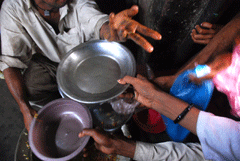
The hungry reached for food in Pakistan during last year’s food crisis. Many fear raising crops for biofuel could force up food prices again. (Photo: Raja Islam)
CURWOOD: What is a drop-in fuel?
LANE: A drop-in is made from biomass but it behaves exactly like diesel or gasoline. It’s called green diesel or green gasoline. So it’s made from bio energy, but when you put it in your car, you don’t need to make any adjustments in the infrastructure, you don’t need to change national pipelines. And basically you can distribute it and use it the same way you use it the same way you do your current fuel, it just has a better emissions picture and it’s certainly made at home and available now.
CURWOOD: For example?
LANE: Well, we can make fuel from algae. And they’re a great solution. They’re called third generation fuels because they don’t change the way we operate our vehicles.
CURWOOD: Jim, do some math here for me. The 2007 Farm Bill requires the United States to produce what some 36 billion gallons of biofuels a year, and that’s designed to cut eleven percent of our greenhouse gas emissions. That would be like taking some 24 million cars off the road. So what are the fuels that we’re gonna use to hit that target?
LANE: Well we’re gonna have fifteen billion gallons are gonna come from conventional biofuels, that’s the corn ethanol and soy based biodiesel that we are currently using today. So it means that we’re not going to be using too much more of that. And then we’re gonna get 16 billion gallons from cellulosic biofuels, and these are made from agricultural residues such as corn stover, stalks, made from forest residues, also made from waste, landfills. And then we’re gonna get four billion gallons of advanced biofuels and these are these drop-in fuels that we’ve talked about made perhaps from algae and other bio energies like that. And then we’ll get a billion gallons of biodiesel, and that’ll be made primarily from soy and from camelina and other kinds of crops like that.

LANE: Well it addresses it in two ways, its very clever actually. First of all, they’ve changed some of the definitions to make them more fuel neutral, so they no longer call for things like cellulosic ethanol, they’re asking for cellulosic biofuels. So, you know, we can fulfill that in a variety of ways, we don’t necessarily have to make ethanol. Secondly, they’ve capped – and this has been for some time – they’ve capped the amount of corn ethanol at 15 billion gallons and we’re very close to that already. So, the message from Washington is very clear that corn ethanol is here to stay, but very much in the volumes that we’re looking at right now, and the future is very much in these advanced biofuels that do not use, in many cases, any land because they’re using residues and waste matter that’s already there or they’re using very high yield substances like algae where we get ten to fifteen times the productivity per acre than we get from corn. So, it’s a real game changer as well as acceleration.
CURWOOD: So, looking at the president’s directive, it asks this interagency group to look at the overall, the life cycle, global warming implications of the new biofuels. How are they going to calculate that?
LANE: Well there’s a direct impact that’s called field to wheels and they measure all the various inputs that go in and some of those are fossil fuels, such as moving fuel and moving feed stock to the plant and from the plant. Then there’s an indirect component and the theory here is that if you produce a lot of biofuels using existing crop land, that’s gonna raise the prices and that will encourage people to do conversion of fallow land or land used for less profitable items such as cattle to bioenergy or food production. So that’s called an indirect impact and that can have emissions. So, it’s very early days in measuring that. There is a model called the GTAP model which is produced by Purdue, and there’s a lot of controversy in the scientific community and there will be a lot of discussion over the next sixty days about exactly how that’s implemented. And I think that as we look at the details that are coming through here, I think we can see that the administration has actually come up with a really, really good way to approach this where they’ve protected to past, but really put us on a future course that’s going to get us into these third generation drop-in fuels very quickly.
CURWOOD: Jim Lane is the editor and publisher of “Biofuels Digest.” Thank you so much, sir.
LANE: Thank you.
Related link:
Biofuels Digest
[MUSIC: Nazz “A Beautiful Song” from 13th And Pine (Stewkey Antoni 1998)]
CURWOOD: Just ahead – veggie power to the people – improving access to healthy food in the inner cities. Stay with us - on Living on Earth.
ANNOUNCER: Support for the Environmental Health Desk at Living on Earth comes from the Cedar Tree Foundation. Support also comes from the Richard and Rhoda Goldman fund for coverage of population and the environment. And from Gilman Ordway for coverage of conservation and environmental change. This is Living on Earth on PRI, Public Radio International.
[CUTAWAY MUSIC: Joey DeFrancesco: “Strollin” from Finger Poppin With…. (Doodlin Records 2009)]
Note on Emerging Science

YOUNG: It’s Living on Earth. I’m Jeff Young.
CURWOOD: And I’m Steve Curwood.
Coming up – a new tool to help you shop greener – but first, this note on emerging science from Lindsay Breslau.
[LOCUSTS BUZZING]
BRESLAU: A small, green grasshopper sits alone on a blade of grass, innocently munching on the juicy stalk. It seems harmless, but beware. One day it may join a gang.
[EMERGING SCIENCE THEME]
In 1921, scientists discovered that the green desert grasshopper is the same species as the destructive, yellow and black locust. But the split personality of the creature remained a mystery.
Recently, a group of researchers from Britain and Australia linked this behavior transformation to serotonin, a brain chemical found in all complex organisms. They discovered that the nervous systems of swarming locusts contain three times as much serotonin as solitary locusts.

A swarm of locusts.
By tickling a grasshopper's hind legs to simulate jostling by other locusts, the scientists could transform the solitary insect into a social creature within hours. To test their theory, they injected a serotonin inhibitor before tickling the legs and found no behavior change. But when the researchers injected a serotonin promoter and didn't stroke the insects, they changed color, grew large muscles, and behaved gregariously.
During droughts, locusts are forced into small areas to look for food. Close contact with other locusts causes this chemical change, creating swarms that can number in the billions.
Scientists hope that this discovery about serotonin will lead to research on how they could rehabilitate the violent gangs of locusts and turn them back into harmless grasshoppers.
That's this week's note on emerging science. I'm Lindsay Breslau.
Food Deserts

YOUNG: When Michelle Obama rolled up her sleeves and started digging a garden on the White House lawn, advocates for healthy local food cheered. The First Lady set a powerful example by inviting Washington, DC schoolchildren to garden along with her.
The message: the inner city, too, can have access to fresh, organic food. And in these tough times this is especially important. Government figures show that some 36 million people live in households that have trouble just putting food on the table.
Jessica Ilyse Smith tells us about efforts in New York City to bring high quality foods to struggling neighborhoods.
[SOUNDS AT A BODEGA]
SMITH: It’s Saturday morning at the Cemalyn Grocery in Brooklyn. Cesar Rodriguez tends to his customers.
[SOUNDS OF RODRIGUEZ RINGING UP CUSTOMERS]
SMITH: Soda, cookies, chips and canned foods line the walls of Rodriguez’s bodega. But, among the sea of processed foods and packaged goods, stands a small outpost of fresh fruits and green leafy vegetables.
[RODRIGUEZ POINTING OUT THE FRUITS AND VEGETABLES IN SPANISH]
SMITH: Rodriguez recently added these fresh foods to his store. He’s one of almost 1,000 bodega owners taking part in New York City’s Healthy Bodegas Initiative.
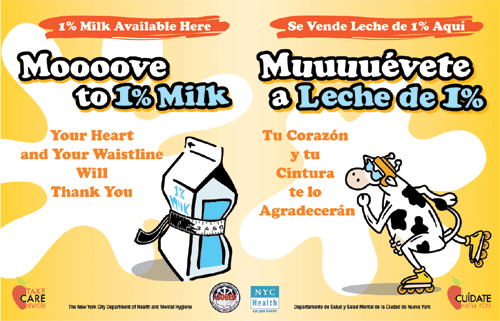
The Health Bodegas Initiative encourages families to drink low-fat milk. (Courtesy of NYC Dept. of Health & Mental Hygiene)
[RODRIGUEZ SPEAKING SPANISH]
VOICEOVER: Through the program, we're trying to improve people’s health and the health of the neighborhood, have people eat healthier products, and lose weight because obesity is a sickness here in our community.
SMITH: Low-income neighborhoods like Rodriguez’s have few supermarkets or other options for fresh fruits and vegetables. Yet there are many places to buy fast food, candy and alcohol.
Sabrina Baronberg of the City’s Department of Health and Mental Hygiene wanted to find ways to address the many health problems like obesity, diabetes and heart disease found in poorer areas. She found that 80% of the food markets in these neighborhoods were small corner stores.
BARONBERG: These areas have many more bodegas than supermarkets and very few supermarkets in fact. That really inspired me to work to make these large environmental changes to make it easier for people to eat healthier.
SMITH: So, in 2006 Baronberg began to work with bodega owners and kicked-off the Healthy Bodegas Initiative. She saw that residents wanted to change what they ate but needed help.
BARONBERG: Nobody wants to live a life of chronic disease. So people would say to me I really want to make these changes, I want to switch to 1% milk, I want to eat more fruits and vegetables, I want to be healthier but I can’t. My bodega only sells junk food and there aren’t any supermarkets. So what am I supposed to do? And, you know, there is nothing more frustrating than that.
SMITH: New York City’s neighborhoods are not the only areas with limited access to healthy food. These so-called food deserts are found across the country in rural and urban locations. Mark Winne has looked at food deserts for years.
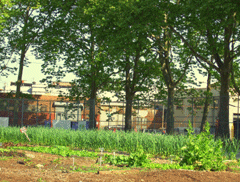
Early growing season at Red Hook Community Farm.
(Photo: Jessica Ilyse Smith)
WINNE: It’s relative based on how far somebody has to go to get to any kind of decent, affordable food store, and the means that they have to get there. And do they in fact have the means?
SMITH: Winne is the author of “Closing the Food Gap: Resetting the Table in the Land of Plenty.” In the book, he chronicles the rise of food deserts in the 1960’s, alongside the growth of the American suburb. With scores of people leaving downtown areas, inner cities were drained of wealth. Supermarket chains followed the wealthier client base and moved to the suburbs.
WINNE: They simply began to walk away from urban America. And these were communities that needed those stores more than others. They were communities that were being challenged by poverty, and challenged by some of the worst socioeconomic conditions that we’ve had perhaps in the 20th century.
SMITH: It wasn’t just the lack of supermarkets that led to the growth of food deserts, but also the lack of public transportation to bring urban residents to suburban grocery stores. Winne says nearly 70% of the households in low-income neighborhoods do not own a car.
As an example he highlights the 8th ward of Washington D.C., which is close to the U.S. Capitol building. In this area, nearly 70,000 residents live with slim access to grocery stores.
WINNE: About 38% of those people are considered poor using U.S. poverty standards. If you look at the landscape we see almost no supermarkets and we also see another characteristic of a food desert, which is a tremendous number of fast food joints. And that’s what people have to choose from for food. And as a result we see very high levels of obesity.
SMITH: Costs from obesity and related chronic diseases are increasing. According to the Centers for Disease Control and Prevention, the U.S. spends over 117 billion dollars a year on healthcare related to obesity. And in low-income neighborhoods with lots of fast food and few healthy options, the obesity rate is rising.
[SOUND OF RAKING LEAVES]
SMITH: Over in the Red Hook neighborhood of Brooklyn, Eugene rakes leaves that he’ll add to one of the compost piles lining the side of an urban farm.
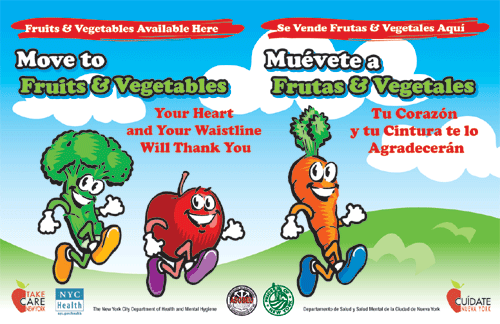
A poster encourages New Yorkers to eat fruits and vegetables to improve health and reduce the risk of diabetes, high-blood pressure, and heart disease. (Courtesy of NYC Dept. of Health & Mental Hygiene)
EUGENE: We have our compost beds over here that we’ve been processing for a long time. We have one that was built two months ago, and it’s almost done but it’s not all the way done. It’s almost broken itself down, all of the nutrients and stuff like almost broken down and created our soil that we use.
SMITH: Eugene is one of about ten neighborhood teens who work at the Red Hook Community Farm. The farm - run by the non-profit group Added Value - was built literally from the ground up. Soil was brought in to cover an old abandoned ball field. If you look closely on the outskirts of the rows of onions, lettuce and beets you can still see home plate and the faint white lines that mark the field’s boundaries.
This farm has not only increased the community’s access to fresh and affordable fruits and vegetables, but also has helped change the neighborhood.
EUGENE: Before the farm I’d say it was pretty much a little badder, because there was still a lot of gang violence and stuff like that going around here. I’m just basically proud of being here and helping out and being able to bring healthy food to my neighborhood that I live in.
SMITH: Eugene and other teens plant seeds, harvest crops and sell their bounty at a farmer’s market in the neighborhood. Before the farm started, residents went through a lot to get fresh food.
KATE: I took two buses or a car service to get food back to Red Hook. I mean you couldn’t even get a quart of milk, or vegetables.
SMITH: Kate and many other Red Hook residents who buy their produce from the farm understand that fresh fruit and vegetables are important for their health. William Lewis is a longtime resident who didn’t like what he found in the neighborhood before the farm.
LEWIS: Well, it was dull, there was nothing you could buy. Not fresh anyway – just regular stores, you know. When the farm came, I just started coming here because I know it’s fresh food, and I like fresh, it’s better for me—it’s better for everyone as a matter of fact, you know?
SMITH: The farmer’s market has become a neighborhood gathering place, and teens at the farm not only earn money and learn how to grow food, they also learn how to be stewards of their community…a community that is focusing on changing the circumstances of its health. Efforts like this inspire author Mark Winne:
WINNE: So it’s the human innovation, creativity, willingness as a community in some sort of organized social way, and political way of trying to change the circumstances that they live in—and that really inspires me.
SMITH: Programs like the Added Value farm and the Healthy Bodegas Initiative operate from the ground up to improve the health of people living in food deserts. They also help to close what Winne calls the food gap that severely divides Americans.
For Living on Earth, I’m Jessica Ilyse Smith in New York City.
Related links:
- Added Value
- Healthy Bodegas Initiative
- “Closing the Food Gap” by Mark Winne
[MUSIC: Annie Ross “Farmers Market” from The Bebop Singers (Prestige records 1950)]
Eco IQ
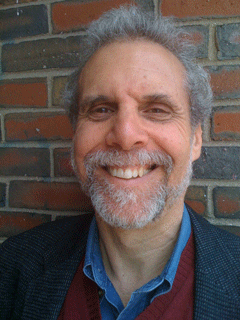
Author Daniel Goleman.
CURWOOD: There used to be a couple of kinds of intelligence -- book smarts, and street smarts.
But longtime New York Times science writer, Dan Goleman, helped topple that limited understanding with his book, “Emotional Intelligence”.
He now joins us to talk about yet another sort of intelligence. Hello Sir.
GOLEMAN: Hi, good to be here Steve.
CURWOOD: So you’re proposing that the well-rounded person should also be “ecologically smart” … in other words how we think about the environment and what we may or may not be able to do about it.
GOLEMAN: It’s even more than that Steve, its how we operate, you and I, as active agents in the ecological world, whether we do it in an intelligent way – one that improves things – or we just stay in our usual stupor and let things drift as they are. I think what we need is a social evolution. We need an evolution in how we live on the planet, how we understand our relationship to nature, how we see ourselves as active agents – that’s what I call ecological intelligence. I think we’ve got to collectively up our level or understanding and insight into how our habits, our manufacturing systems are damaging the planet and how we each can act when we shop to favor improvements that will accelerate the innovative thinking to find better ways of doing it. In other words, make it pay for companies to do the right thing.
CURWOOD: You’re new book “Ecological Intelligence” the subtitle is “How knowing the hidden impacts of what we buy can change everything.” It’s encountering, I suspect, a bit of resistance among some ecological thinkers who are quite skeptical of our ability to buy our way out of the ecological crisis that we find ourselves in today. How do you respond to that criticism?
GOLEMAN: It’s our habits of consumption that are driving the industrial machine, which is destroying the planet. So, if you and I knew the hidden impacts of the things we buy every time we shop, and we simply favored improvements, and let other people know, we would shift market share in a way which makes it feasible, in fact, essential for companies to speed up the changes in their manufacturing platforms and their chemicals and so on, that will make the planet a better place.
CURWOOD: Now, I see towards the back of your book you sent me to some software that I can put on my iPhone, and I have to confess that in advance of this interview I did this, I downloaded it. The app is called Good Guide.
GOLEMAN: Free app.
CURWOOD: I have to ask you this question, so do you make money off this app?
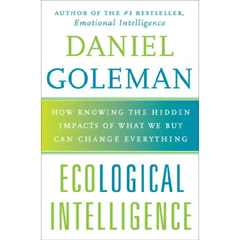
GOLEMAN: I have nothing to do with it, but I actually dreamed it twenty years ago before it existed, and I wished that there were a program that would tell us when we go shopping what the actual impacts – ecological impacts – of what we’re going to buy are. Then a couple years ago, I heard there was someone at Berkeley developing just that. I got very excited. That was one of the things that occurred to me to write the book.
CURWOOD: Alright, well, let’s go shopping then with your software.
GOLEMAN: Let’s do that. Lovely Steve.
[PACKING UP SOUNDS]
CURWOOD: Let’s see. So, grab your coat.
GOLEMAN: Okay. I’ll assume we’re coming back.
CURWOOD: And we’ll come with our producer, Ike.
[WALKING OUT OF THE ROOM, DOOR OPENING]
GOLEMAN: Beautiful day. What were we doing inside?
[TRAFFIC SOUNDS]
CURWOOD: So, we head to a drug store a few steps away from our studio. The iPhone app is loaded with ratings of the environmental health and social impacts of 70,000 or so consumer products.
[OVERHEAD ANNOUNCEMENT IN DRUG STORE]
CURWOOD: Seems to me that we’re always running out of shampoo at my house. So let’s take a look here at the shampoo rack and see what we will…
GOLEMAN: Well let’s see what Good Guide recommends.
CURWOOD: Alright. It’s over here. Well these are all fairly big brands. Let’s just randomly pick one and see how well it does. Here’s VO5.
GOLEMAN: Herbal shampoo.
CURWOOD: Herbal Escapes shampoo. So let’s see. Find, I click on here. Search, little wheel is spinning. Okay. It gets an overall rating of a 3.9, that’s not so wonderful is it.

Author Daniel Goleman
GOLEMAN: That’s really close to the lowest third and the shampoo does a little better in the health. Its gets 5.0 meaning its ingredients are kind of average in terms of chemicals of concern and so on. But environmentally and socially it didn’t do as well. The reasons are that although the company has a minimum of community related controversies, you know, that might be anything from what are you doing to our local water or what toxins are you dumping in the landfills here to how they’re using land and so on. They have pretty good community relations, but what are those Xs there, those red Xs?
CURWOOD: Compared to other companies, this company is one of the lowest rated in labor and human rights. It then goes on to say this company is not transparent about its corporate practice disclosures.
GOLEMAN: I think what’s happening there is the Good Guide is trying to move companies towards transparency by penalizing those that don’t disclose.
CURWOOD: To find out more let’s look in the category to see if there might be a choice that Good Guide would prefer. So at the very top of the list we see Burt’s Bees, Nurture My Body, Suave shampoo – 8.4, Finesse shampoo – those aren’t terribly expense.
GOLEMAN: Well, you know, I once looked at the ten shampoos that are rated the complete safest. And the ten that have the most chemicals of concern in them. And by far the single most expensive shampoo of the twenty was in the ten worst batch, so you can’t equate cost with safety, with environmental impact. It’s a common assumption, but we really need to challenge our thinking here. And also the more large companies get into the game of getting better and better, the cheaper the good stuff is gonna be.
[TRAFFIC SOUNDS, WALKING ON THE STREET, WALKING UP STAIRS, OPENING DOORS]
CURWOOD: Well we’re back at the Living on Earth offices. Thanks for taking me shopping Dan Goleman.
GOLEMAN: Steve, it was a real pleasure. I never had such fun in a store. [Laughing]
CURWOOD: Dan Goleman’s new book is called “Ecological Intelligence: Knowing how the hidden impacts of what we buy can change everything.”
GOLEMAN: Thanks Steve!
CURWOOD: You can try your own shopping list on Good Guide even if you don’t have an iPhone. Find out more by visiting our website, loe.org.
By the way, we spoke to the Alberto Culver company, the makers of VO5, about their poor review in the Good Guide. A company spokesman says they’re looking into it.
Related links:
- Click here to check how eco smart your shopping list is.
- Check out Daniel Goleman’s blog
[MUSIC: Laurie Johnson “Happy Go Lively” from Music For TV Dinners (Scamp Records 1997)]
YOUNG: Living on Earth is produced by the World Media Foundation.
Our crew includes Bobby Bascomb, Eileen Bolinsky, Bruce Gellerman, Ingrid Lobet, Helen Palmer, Ike Sriskandarajah, and Mitra Taj, with help from Sarah Calkins and Marilyn Govoni.
CURWOOD: Our interns are Lindsay Breslau, Liz Gross, Phil DiMartino and Christine Parrish. Jeff Turton is our technical director. Alison Lirish Dean composed our themes. You can find us anytime at loe.org.
I’m Steve Curwood
YOUNG: And I’m Jeff Young. Thanks for listening.
ANNOUNCER: Funding for Living on Earth comes from the National Science Foundation, supporting coverage of emerging science, and Stonyfield Farm: organic yogurt and smoothies. Stonyfield pays its farmers not to use artificial growth hormones on their cows. Details at stonyfield.com.
Support also comes from you our listeners, the Ford Foundation, the Town Creek Foundation, and the Oak Foundation, supporting coverage of climate change and marine issues; The Bill and Melinda Gates Foundation, dedicated to the idea that all people deserve the chance to live a healthy productive life. Information at gates foundation.org; and Pax World Mutual Funds: socially and environmentally sustainable investing. Pax World: for tomorrow. On the web at paxworld.com.
ANNOUNCER: PRI, Public Radio International.
Living on Earth wants to hear from you!
Living on Earth
62 Calef Highway, Suite 212
Lee, NH 03861
Telephone: 617-287-4121
E-mail: comments@loe.org
Newsletter [Click here]
Donate to Living on Earth!
Living on Earth is an independent media program and relies entirely on contributions from listeners and institutions supporting public service. Please donate now to preserve an independent environmental voice.
NewsletterLiving on Earth offers a weekly delivery of the show's rundown to your mailbox. Sign up for our newsletter today!
 Sailors For The Sea: Be the change you want to sea.
Sailors For The Sea: Be the change you want to sea.
 The Grantham Foundation for the Protection of the Environment: Committed to protecting and improving the health of the global environment.
The Grantham Foundation for the Protection of the Environment: Committed to protecting and improving the health of the global environment.
 Contribute to Living on Earth and receive, as our gift to you, an archival print of one of Mark Seth Lender's extraordinary wildlife photographs. Follow the link to see Mark's current collection of photographs.
Contribute to Living on Earth and receive, as our gift to you, an archival print of one of Mark Seth Lender's extraordinary wildlife photographs. Follow the link to see Mark's current collection of photographs.
 Buy a signed copy of Mark Seth Lender's book Smeagull the Seagull & support Living on Earth
Buy a signed copy of Mark Seth Lender's book Smeagull the Seagull & support Living on Earth

